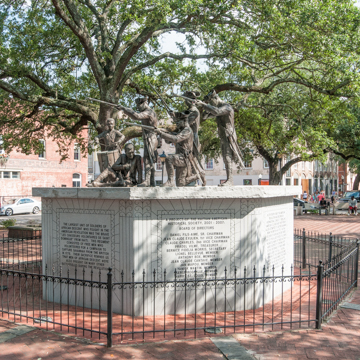In keeping with the squares in the city's eastern expansion wards, Franklin Square is roughly half the size of those within Oglethorpe's original six wards. From 1853 to the early twentieth century it was marked by an 87-foot-tall brick and iron water tower. Franklin, Liberty, and Elbert squares were largely obliterated by the transformation of Montgomery Street into U.S. 17 between 1935 and 1937, but Franklin Square—a gathering place for day laborers for decades, both before and after its destruction—was restored in 1985. In 2007 a monument to Haitian Volunteers (James Mastin, sculptor) who fought in the Battle of Savannah in 1779 was erected in the center of the square.
In conjunction with the reclamation of Franklin Square, the City closed a two-block section of St. Julian Street to automobile traffic in 1985 and, in a successful attempt to lure shoppers to return to the downtown, leased the street to a retail management company that calls the outdoor mall "City Market"—invoking the spirit of the lamented market structure in nearby Ellis Square, which was demolished in 1954. The commercial buildings lining this mall date from the 1840s to the early twentieth century. Unlike many conversions of main streets to pedestrian-only spaces in the 1970s, City Market has been highly effective in attracting both locals and tourists to its shops, outdoor cafes, and informal performance spaces.














